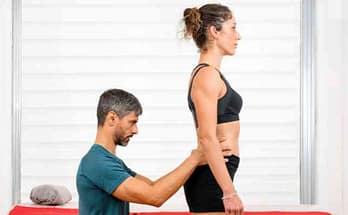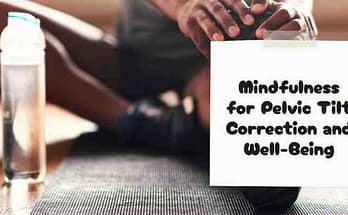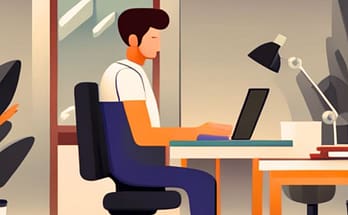Are you struggling with persistent back pain? The key to finding relief might lie in understanding pelvic tilt. When your pelvis is tilted too far forward or backward, it can strain your back muscles and lead to chronic pain. In this article, we’ll explore the causes, symptoms, diagnosis, treatment, and prevention of pelvic tilt. By learning about pelvic tilt, you can alleviate your back pain and enjoy a healthier, more active life.
| Key Takeaways |
|---|
| Pelvic tilt can be caused by poor posture, muscle imbalances, pregnancy, injury, and certain athletic activities. |
| There are different types of pelvic tilt, including anterior tilt (forward), posterior tilt (backward), and lateral and rotational tilt. |
| Pelvic tilt can lead to chronic pain, affecting daily tasks, balance, stability, and even mental well-being. |
| Treatment options for pelvic tilt include correcting posture, specific exercises to strengthen core muscles and target hip flexors and hamstrings, physical therapy and manual therapy techniques, and, in severe cases, medications and surgery. |
| Prevention of pelvic tilt can be achieved through maintaining good posture, regular exercise, avoiding prolonged sitting or standing, using ergonomic furniture, practicing proper sitting and standing posture, incorporating yoga into routine, and taking regular breaks to maintain posture awareness. |
Symptoms of Back Pain Caused by Pelvic Tilt
Experiencing discomfort in the lower back can be a sign of pelvic tilt, which can also affect balance and stability during everyday activities like walking or running.
When the pelvis is tilted forward or backward, it can create an imbalance in the spine, resulting in back pain. This pain can range from mild to severe and may radiate from the lower back to the hips and even down the legs.
Managing back pain caused by pelvic tilt is crucial. Correcting your posture can help alleviate pain and improve overall balance and stability. Exercises that strengthen core muscles, such as the transverse abdominis and gluteal muscles, are beneficial in addressing the underlying cause of back pain.
Additionally, specific stretching exercises targeting the hip flexors and hamstrings can aid in correcting pelvic tilt. By addressing the root cause of your back pain, you can improve your quality of life and prevent future injuries.
Therefore, understanding the symptoms associated with back pain caused by pelvic tilt is vital, allowing you to take proactive steps toward managing and resolving it.
What is Pelvic Tilt?
Your pelvic tilt plays a significant role in your posture. It refers to the way your pelvis is positioned and tilted in relation to your spine.
There are two primary types of pelvic tilt: anterior tilt and posterior tilt. Anterior tilt occurs when your pelvis tilts forward, causing your lower back to arch excessively. Conversely, posterior tilt refers to a backward tilt of the pelvis, resulting in a flattened lower back.
Pelvic tilt can stem from various causes, including poor posture, muscle imbalances, pregnancy, and activities that require lower body strength. Athletes who engage in weightlifting and running, for example, are at risk of developing pelvic tilt.
Correcting pelvic tilt is crucial, especially for athletes, as it can enhance performance, reduce the risk of injury, and alleviate back pain. Stretching, strengthening exercises, and postural correction can all contribute to correcting pelvic tilt.
Check out more posts on pelvic tilt;
Unlocking the Power of Pelvic Tilt for Athletic Performance
Age Gracefully: The Importance of Pelvic Tilt in Maintaining Posture and Movement as You Age
Unlocking the Secrets of Pelvic Tilt: How Proper Alignment Can Improve Your Posture and Health
Aligning the Body: How Yoga Can Correct Pelvic Tilt and Improve Your Health
Transform Your Life: Benefits of Correcting Pelvic Tilt
Causes of Pelvic Tilt
Tight hip muscles are a common cause of pelvic tilt as they pull the pelvis out of alignment. This can lead to an anterior pelvic tilt, where the front of the pelvis drops and the lower back arches excessively, or a posterior pelvic tilt, where the back of the pelvis drops and the lower back flattens.
Other types of pelvic tilt include lateral pelvic tilt, where one side of the pelvis is higher than the other, and rotational pelvic tilt, where the pelvis twists to one side.
Pelvic tilt can have a significant impact on posture and movement. Depending on the type and severity of the tilt, it can cause pain and discomfort in the lower back, hips, and legs. It can also affect balance and stability during activities like walking, running, and standing, leading to compensations in other parts of the body, such as increased tension in the shoulders and neck.
Understanding the causes of pelvic tilt is essential to effectively address the condition and alleviate associated symptoms.
Diagnosis of Pelvic Tilt
To diagnose pelvic tilt, your healthcare provider will likely conduct a physical examination, which may involve observing your posture and gait, testing your range of motion, and palpating your pelvic area.
Imaging tests such as X-rays or MRI scans may also be ordered to confirm the diagnosis and assess the severity of the tilt.
By conducting a thorough evaluation, your provider can accurately diagnose pelvic tilt and create a suitable treatment plan to alleviate your symptoms.
Physical Examination
During a physical examination, your doctor will assess the degree of your pelvic tilt and determine if it’s contributing to your back pain. They may perform range-of-motion tests and palpation techniques to identify any imbalances in your pelvic region. These tests can help determine if you have an anterior or posterior pelvic tilt and the extent to which it affects your posture and causes back pain.
Physical therapy and manual therapy techniques can address pelvic tilt and alleviate back pain. Your doctor may recommend exercises to strengthen the muscles supporting your spine and improve your posture. They may also suggest manual therapy techniques such as spinal manipulation or massage to release tension and enhance mobility in your pelvic region.
By identifying and addressing pelvic tilt, your doctor can help you achieve better alignment, reducing pressure and strain on your back.
Imaging Tests
If you experience persistent lower back discomfort, imaging tests may be beneficial in identifying underlying issues contributing to your pain. Advances in imaging accuracy have made X-rays, CT scans, and MRI scans effective diagnostic tools for identifying conditions such as herniated discs, spinal stenosis, and vertebral fractures.
These imaging tests provide detailed images of your spine, enabling healthcare professionals to accurately diagnose and treat your condition. However, it’s important to note that imaging tests may not always be necessary and can sometimes lead to unnecessary treatments or surgeries.
An abnormality on an imaging test doesn’t always correlate with pain, and conversely, pain can exist without any abnormalities on imaging. Furthermore, imaging tests may identify alternative diagnoses unrelated to your back pain. Thus, a thorough physical examination and consultation with your healthcare provider are essential to determine the necessity of imaging tests and evaluate potential risks and benefits.
Treatment of Pelvic Tilt
Treating pelvic tilt involves various options. Stretching and strengthening exercises can improve muscle imbalances and enhance the range of motion in your hips and lower back. Chiropractic and physical therapy can realign your pelvis and improve overall posture. In severe cases, medications and surgery may be necessary to alleviate symptoms and correct pelvic tilt.
Stretching and Strengthening Exercises
While exercises alone may not fully correct pelvic tilt, they play a crucial role in managing the condition.
Stretching exercises relieve tension in tight muscles and improve flexibility, while strengthening exercises target weaker muscles surrounding the pelvis. Incorporating proper breathing techniques during exercises aids in improving pelvic tilt.
Deep breathing helps release muscle tension and promotes relaxation, ultimately leading to better pelvis alignment. Yoga, a practice combining stretching and breathing techniques, has proven beneficial in improving pelvic tilt and reducing back pain.
By regularly practicing yoga and incorporating these exercises into your routine
, you can improve your pelvic tilt and alleviate back pain.
Chiropractic and Physical Therapy
Chiropractic and physical therapy are effective treatments for addressing pelvic alignment issues and reducing lower back discomfort. Chiropractors use manipulation techniques to reposition pelvic bones and realign the spine, alleviating pain and improving overall function.
Physical therapists employ exercises and stretches to strengthen pelvic muscles and enhance flexibility. Both approaches can be effective, with the choice depending on individual needs and preferences.
Pelvic floor exercises also benefit individuals experiencing lower back pain. Strengthening pelvic region muscles improves overall stability and reduces the risk of injury.
Research supports the effectiveness of pelvic floor exercises in reducing lower back pain in both men and women. These exercises also improve bladder and bowel control, which is particularly beneficial for postpartum women and those with pelvic organ prolapse. Incorporating pelvic floor exercises alongside chiropractic or physical therapy interventions enhances treatment outcomes.
| Chiropractic | Physical Therapy |
|---|---|
| Involves manipulation techniques to realign the spine and pelvic bones | Uses exercises and stretches to strengthen pelvic muscles |
| Can effectively reduce lower back pain and improve function | Improves flexibility and overall stability in the pelvic region |
| Preferred by those who prefer hands-on treatment approaches | Preferred by those who prefer exercise-based treatment approaches |
| Effective as a standalone treatment or in combination with others | Effective as a standalone treatment or in combination with others |
Medications and Surgery
When other treatments fail to provide relief, medications and surgery may be considered for managing lower back pain. Non-steroidal anti-inflammatory drugs (NSAIDs), muscle relaxants, and opioid pain medications offer temporary relief. However, it’s crucial to be aware of potential side effects and risks associated with long-term medication use.
NSAIDs, for example, can cause stomach ulcers and kidney damage, while opioids carry the risk of addiction and overdose. Surgery may be an option if medications prove ineffective or unsuitable. However, it’s crucial to explore non-invasive treatment options before considering surgery.
Surgery may be recommended for conditions such as spinal stenosis, herniated discs, or sciatica. While surgery can provide relief, it also involves risks and requires a lengthy recovery process. Non-invasive alternatives, including physical therapy, chiropractic care, and other treatments, should be exhausted before opting for medication or surgery.
Discuss all available options with your healthcare provider to determine the most suitable treatment plan for your individual needs.
Prevention of Pelvic Tilt
Preventing pelvic tilt involves maintaining good posture, engaging in regular exercise, and avoiding prolonged sitting or standing. Good posture entails keeping your spine straight, shoulders relaxed, and feet firmly planted on the ground.
Regular exercise strengthens the muscles supporting the pelvis, while avoiding prolonged sitting or standing alleviates pressure on the lower back. By incorporating these habits into your daily routine, you can prevent pelvic tilt and reduce the risk of back pain.
Maintaining Good Posture
Improving your posture and alleviating back pain can be achieved by maintaining proper alignment of your pelvis. Here are some tips to help:
- Use ergonomic furniture: Invest in ergonomic chairs and desks to maintain proper spinal alignment during extended periods of sitting.
- Practice proper sitting and standing posture: Keep your feet flat on the floor, shoulders relaxed, and maintain a straight line between your ears, shoulders, and hips.
- Strengthen your core muscles: Strengthening the muscles in your abdomen and back provides support for your spine and improves posture.
- Incorporate yoga into your routine: Yoga poses that stretch tight muscles and strengthen weak ones can help improve posture.
Additionally, mindfulness of your posture throughout the day is essential. Take breaks to stretch and move around, avoiding slouching or hunching over when sitting or standing. With consistent effort, maintaining good posture becomes a habit that alleviates back pain and improves overall health.
Regular Exercise
Incorporating regular exercise into your routine is essential for maintaining overall health and preventing future back issues. Yoga is particularly beneficial for relieving back pain. It improves flexibility and strengthens the muscles that support your spine while promoting relaxation and reducing stress. These combined benefits make yoga an excellent choice for back pain relief.
Cardiovascular exercises, such as running, cycling, or swimming, are also vital for a healthy back. Engaging in aerobic activities improves blood flow and oxygenation to your back muscles, reducing pain and stiffness. Regular cardiovascular exercise has even been linked to a reduced risk of developing back pain in the first place, making it an important component of any back pain prevention plan.
Incorporating both yoga and cardiovascular exercise into your routine helps alleviate back pain and improve overall health.
Avoiding Prolonged Sitting or Standing
Avoiding long periods of sitting or standing can prevent future back issues and promote better overall health. In today’s modern world, it’s common to spend extended hours sitting at a desk or standing in one place. However, these habits strain your back and may lead to long-term pain.
To prevent this, it’s essential to take breaks and utilize ergonomic furniture. Follow these tips to avoid prolonged sitting or standing:
- Take breaks: Take regular breaks every 30 minutes to an hour to stretch, walk around, or change positions. These breaks prevent muscle fatigue and improve blood flow to your back muscles.
- Use ergonomic furniture: Invest in ergonomic furniture, such as standing desks or ergonomic chairs, to reduce strain on your back. Ergonomic furniture provides support and comfort, helping to prevent future back pain.
- Mind your posture: Maintain good posture whether sitting or standing. Keep your back straight, shoulders relaxed, and feet flat on the floor. These practices reduce strain on your back muscles and promote proper spinal alignment.
Incorporating these habits into your lifestyle prevents prolonged sitting or standing, reducing the risk of future back issues.
Understanding pelvic tilt and its impact on back pain is crucial for relief and improved well-being. Address the causes, explore treatments, and prioritize good posture and regular exercise. Consult a healthcare professional for personalized guidance. Take charge of your back health and start today!




